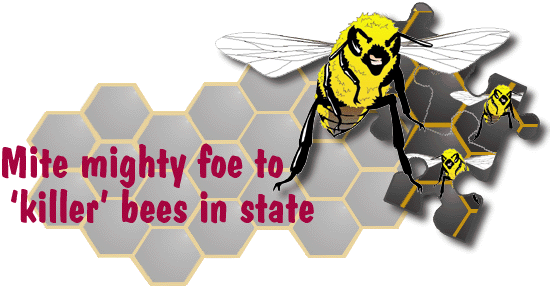
Illustrated by: Dr. Biology
Images in this article are linked to more information.
.jpg)
Africanized "killer" bees have fallen prey to a deadly predator of their own- parasitic mites whose infestation has dropped their wild colony numbers by as much as 70 percent statewide. This may be good news to people who fear attack by the aggressive Africanized bees, a hybrid of the honeybee whose swarms have led to three deaths since their migration into Arizona in 1993. But the same mites may eventually increase the Africanized bee population, say experts. So far the trachea and varroa mites attacks on honeybees have kept the Africanized bee population from exploding as projected when they first migrated to the state in 1993, said Jennifer Fewell, an Arizona State University biologist who has been studying honeybees since 1985.
The Africanized bees may be developing resistance to the mites more rapidly than honeybees, meaning Africanized bee colonies are slowly replacing the dying honeybees. "In 1993 or 1994, right before the Africanized bees came into the area the population went from 200 colonies in the area we were studying (near Oracle Junction) to less than 10," Fewell said. "Those were all (wild honeybee) hives and then the next year we saw the African bees move into it and it's now more than 50 percent African."
There are now 50 hives in the area and they are mostly Africanized, Fewell said. As nature continues to wage its parasitic war, beekeepers say they are feeling the loss. Mesa beekeeper Ken Orletsky figures parasitic mites have cost him close to $1 million over the last 10 years. Lenard Hines, a Sierra Vista beekeeper, said he lost several thousand dollars in 1989 and 1990 when trachea mites decimated over 200 of his 660 hives. "I think it would be fair to say that this mite represents the most severe losses to the beekeeping industry that it's ever faced," said Eric Erickson, director of the U.S. Department of Agriculture's Carl Hayden Bee Research Center in Tucson.
.jpg)
Orletsky, the president of the Arizona Beekeepers Association, estimates that only about 12 commercial beekeepers remain in Arizona. "We've lost hundreds of beekeepers," Orletsky said. "This could be a very serious shortfall." Orletsky and his wife own Bee World Inc., a pollination firm with at least 3,500 hives. Their bees pollinate for major food producers and they worry what the decline in the bee population will mean for the industry. "The thing is if we don't have the bees here to pollinate these crops, we will have to get produce from somewhere else," Orletsky's wife, Pat, said. The mites attack the bees by invading their larva cells inside the hive, explained Erickson. As the larva advances to the pupa stage, the mite begins to feed, then gives birth to baby mites which mate with one another, Erickson explained. When the adult bee emerges from its larva cocoon, the mites come out with it.
"The impact on the colony is the production of a population of worker bees that are shorter-lived, weaker and sometimes deformed," Erickson said. "All that just leads to the decline of the colony until eventually it dies out." Beekeepers are fighting the infestation with a chemical called Apistan and by breeding hives that show the greatest resistance. "It's going to be a long, slow process," Erickson said.
Read more about: Mite Mighty Foe to 'Killer' Bees in State
Bibliographic details:
- Article: Mite Mighty Foe to 'Killer' Bees in State
- Author(s): Paul Matthews of the Tribune Newspapers of Arizona
- Publisher: Arizona State University School of Life Sciences Ask A Biologist
- Site name: ASU - Ask A Biologist
- Date published:
- Date accessed:
- Link: https://askabiologist.asu.edu/explore/mite-mighty-foe-killer-bees-state
APA Style
Paul Matthews of the Tribune Newspapers of Arizona. (). Mite Mighty Foe to 'Killer' Bees in State. ASU - Ask A Biologist. Retrieved from https://askabiologist.asu.edu/explore/mite-mighty-foe-killer-bees-state
Chicago Manual of Style
Paul Matthews of the Tribune Newspapers of Arizona. "Mite Mighty Foe to 'Killer' Bees in State". ASU - Ask A Biologist. . https://askabiologist.asu.edu/explore/mite-mighty-foe-killer-bees-state
Paul Matthews of the Tribune Newspapers of Arizona. "Mite Mighty Foe to 'Killer' Bees in State". ASU - Ask A Biologist. . ASU - Ask A Biologist, Web. https://askabiologist.asu.edu/explore/mite-mighty-foe-killer-bees-state
MLA 2017 Style
Be Part of
Ask A Biologist
By volunteering, or simply sending us feedback on the site. Scientists, teachers, writers, illustrators, and translators are all important to the program. If you are interested in helping with the website we have a Volunteers page to get the process started.


